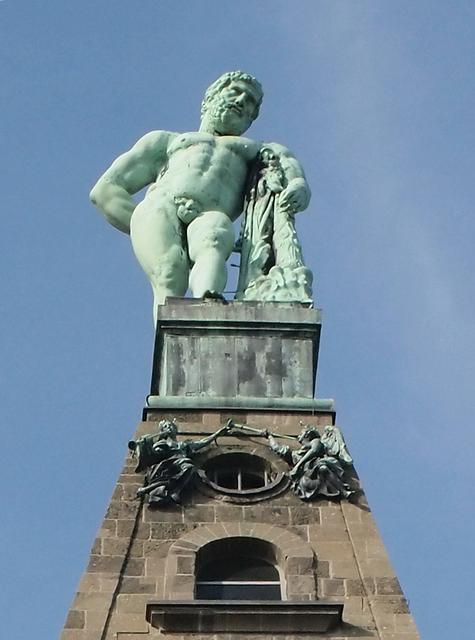 Kassel (pop ~ 200 000) is the most important city of North Hesse. It is known around the world for the documenta exhibitions of contemporary art every five years. Furthermore, the "Bergpark Wilhelmshöhe" with its water displays received the title "UNESCO-World Heritage Site" in 2013.
Kassel (pop ~ 200 000) is the most important city of North Hesse. It is known around the world for the documenta exhibitions of contemporary art every five years. Furthermore, the "Bergpark Wilhelmshöhe" with its water displays received the title "UNESCO-World Heritage Site" in 2013.
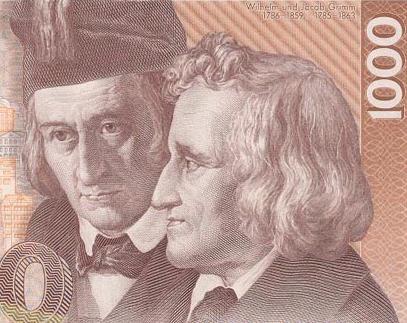
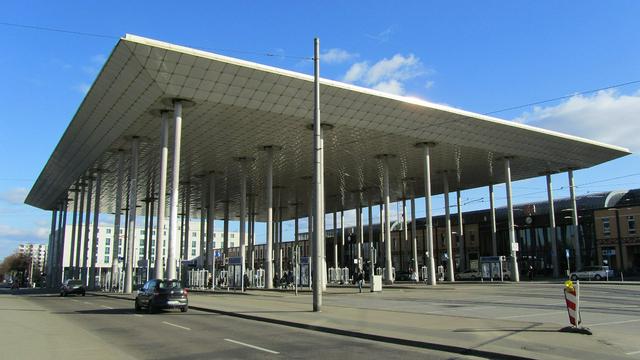 Kassel traces its history to a first mention in 913 CE, but archaeological finds indicate human habitation at this site predating the 10th century. And the city would soon become a centre and later residence of the Ladgraviate of Hesse.
Kassel traces its history to a first mention in 913 CE, but archaeological finds indicate human habitation at this site predating the 10th century. And the city would soon become a centre and later residence of the Ladgraviate of Hesse.
During the Thirty Years War Kassels Landgraf Philipp declared for the Protestants. This had an effect as later numerous Huguenots emigrated from France and brought with them their trade and skills. The impact of the Huguenots can still be witnessed in the centre of Kassel where streets are named after Huguenots.
Kassel became a considerable industrial and scientific city as can still be seen in the Orangerie museum where loads of scientific kit from the enlightenment period is on show. Noticeably the first steam pot producing a fountain was constructed in Kassel by Papin and rumours have it that he left Kassel in his steam boat a few years before James Watt got his prototype into shape.
Kassel was already a heavy industries site by World War II, where trains, tanks and planes were constructed. In the later years of the war Kassel was thoroughly bombed as a military target by English and American planes.
Kassel was home to the famous Brothers Grimm who wrote a lot of the fairy tales Disney uses today. A less well known but perhaps more important piece of their work was an attempt at a "complete" dictionary of the German language, that was only completed after their death. The house that they lived in was made into a museum with a lot of interesting artefacts.
The Centre of Kassel itself was thoroughly destroyed during the Second World War and therefore rebuilt in the incredibly bland 1950s style (which in fairness was partially due to budget constraints and admitted to be ugly even back then). Hence, the inner city is mainly dominated by bank and mall buildings of the modern sort.
- Tourist Information City Centre, Wilhelmsstraße 23, +49 561 707707. M-Sa 09:00-18:00.
- Tourist Information Wilhelmshöhe, Willy-Brandt-Platz 1, +49 561 34054. M-Sa 09:00-18:00. at the train station Kassel-Wilhelmshöhe
- Visitor Centre Wilhelmshöhe, Wilhelmshöher Allee 380, +49 561 31680751. 1 May-3 October: daily 10:00-17:00; 4 October-30 April: Sa Su 10:00-16:00.
- Visitor Centre Hercules, Schlosspark 28, +49 561 31680781. Tu-Su 10:00-17:00; 15 March-15 November: daily 10:00-17:00.
Tourist Information City Centre, Wilhelmsstraße 23, +49 561 707707. M-Sa 09:00-18:00.
Tourist Information Wilhelmshöhe, Willy-Brandt-Platz 1, +49 561 34054. M-Sa 09:00-18:00. at the train station Kassel-Wilhelmshöhe
Visitor Centre Wilhelmshöhe, Wilhelmshöher Allee 380, +49 561 31680751. 1 May-3 October: daily 10:00-17:00; 4 October-30 April: Sa Su 10:00-16:00.
Visitor Centre Hercules, Schlosspark 28, +49 561 31680781. Tu-Su 10:00-17:00; 15 March-15 November: daily 10:00-17:00.
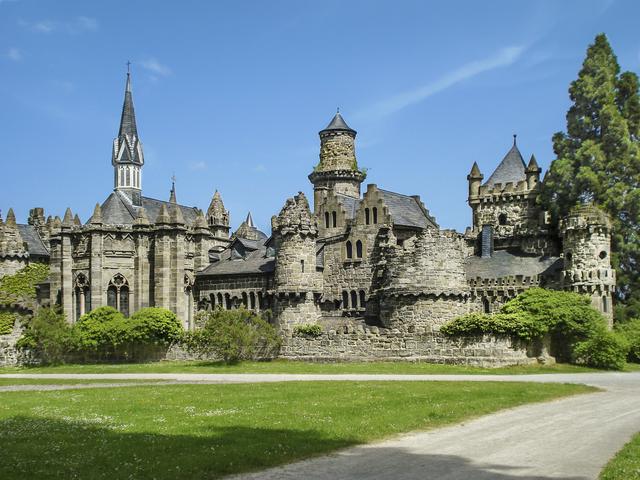
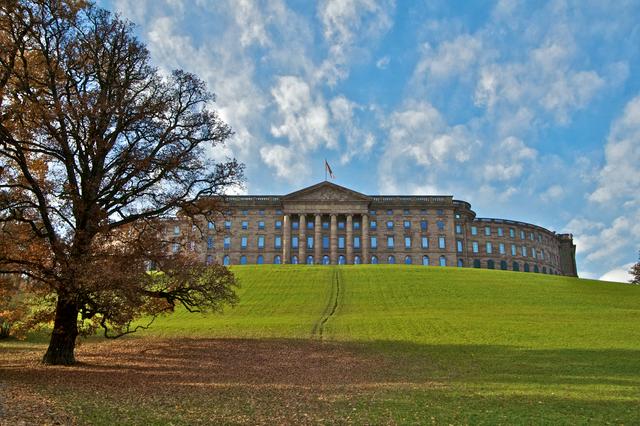
- Bergpark Wilhelmshöhe. Since 2013 on the UNESCO World Heritage List, worth visiting is the "Bergpark" (Mountainpark) which is supposedly the largest in Europe and second largest park on a mountain slope in the world. The park contains the Herkules statue at its top end which is towering over the city and has become its symbol. Further the park contains loads of smaller features which are mainly fake Greek temples, fake medieval castles, fake quarries - you see where we are getting. Not fake though are the Rembrandts and Rubens paintings in the Schloss in the park - an entrance fee is charged. The Park also features during summer months (may 1st until october 3rd) the Wasserspiele (watergames) every Wednesday, Sunday and on public holidays starting from 14:30. Various of the features such as the Cascades (below the Herkules statue), the fake waterfall and the fake Roman Aqueduct have their water supplies opened for half an hour or so each and the crowd of tourists will move from feature to feature starting on the higher parts moving down slope. Löwenburg and Schloss Wilhelmshöhe (palace Wilhelmshöhe) with its old masterpieces of art.
- Karlsaue State Park. Karlsaue, another, French-style park with some old buildings containing all sort of museums (tapstries to astrology). That area is also the usual place for the Documenta art exhibition to happen every five years (next summer 2017). Siebenbergen flower island (Blumeninsel Siebenbergen). Orangerie. Cabinet of Astronomy and Physics with planetarium (Astronomisch Physikalisches Kabinett mit Planetarium). Marble Baths (Marmorbad)
Bergpark Wilhelmshöhe. Since 2013 on the [[UNESCO World Heritage List]], worth visiting is the "Bergpark" (Mountainpark) which is supposedly the largest in Europe and second largest park on a mountain slope in the world. The park contains the Herkules statue at its top end which is towering over the city and has become its symbol. Further the park contains loads of smaller features which are mainly fake Greek temples, fake medieval castles, fake quarries - you see where we are getting. Not fake though are the Rembrandts and Rubens paintings in the Schloss in the park - an entrance fee is charged. The Park also features during summer months (may 1st until october 3rd) the Wasserspiele (watergames) every Wednesday, Sunday and on public holidays starting from 14:30. Various of the features such as the Cascades (below the Herkules statue), the fake waterfall and the fake Roman Aqueduct have their water supplies opened for half an hour or so each and the crowd of tourists will move from feature to feature starting on the higher parts moving down slope. Löwenburg and Schloss Wilhelmshöhe (palace Wilhelmshöhe) with its old masterpieces of art.
Karlsaue State Park. Karlsaue, another, French-style park with some old buildings containing all sort of museums (tapstries to astrology). That area is also the usual place for the Documenta art exhibition to happen every five years (next summer 2017). Siebenbergen flower island (Blumeninsel Siebenbergen). Orangerie. Cabinet of Astronomy and Physics with planetarium (Astronomisch Physikalisches Kabinett mit Planetarium). Marble Baths (Marmorbad)
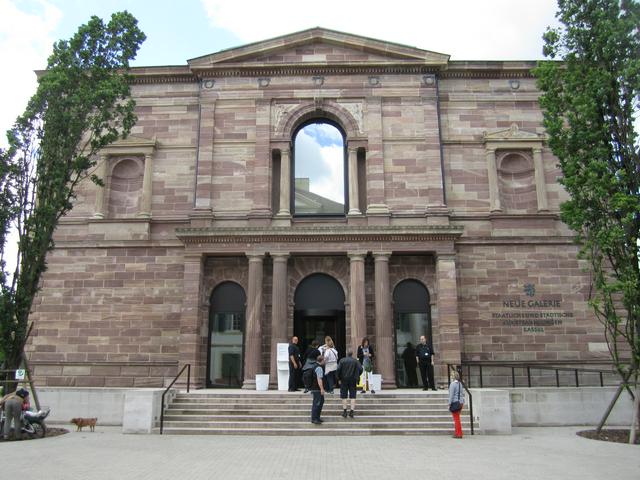
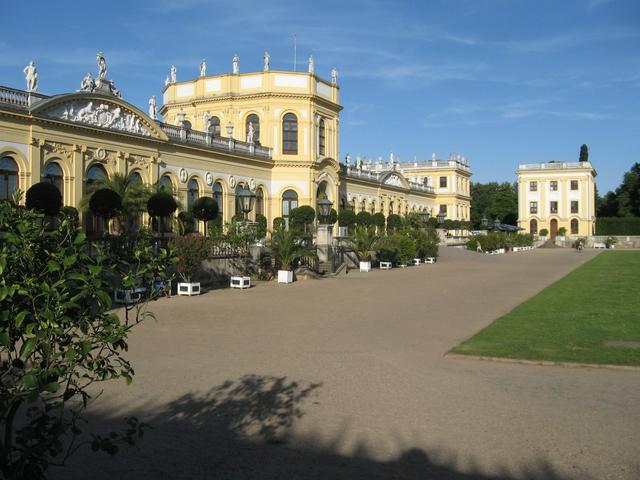
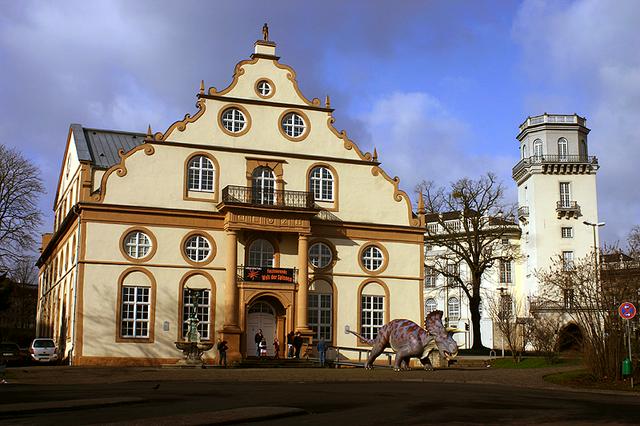
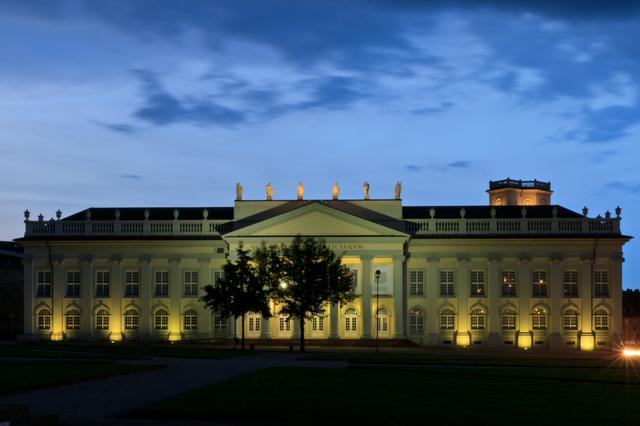
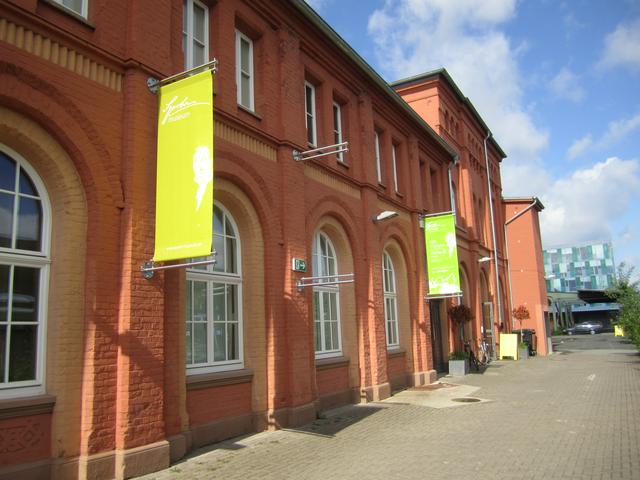
- Löwenburg, Bergpark Wilhelmshöhe (Waldorfschule (Line 3), +49 561 31680244. 1 March-15 November: Tu-Su 10:00-17:00, W 10:00-20:00; 16 November-29 February: F-Su 10:00-16:00. The Löwenburg was built between 1793 and 1801. Although it seems on the first view as a romantic knight’s castle from the Middle Ages, it is a pleasure palace for Landgrave Wilhelm IX of Hesse-Cassel. The castle is one of the first significant buildings of the Gothic Revival architecture in Germany. Visitors can inspect armours, weapons and baroque rooms.
- Museum Schloss Wilhelmshöhe, Schlosspark 1 (Wilhelmshöhe (Park) (Lines 1 and 23), +49 561 316800. Tu-Su 10:00-17:00, W 10:00-20:00. with Collection of Antiques and Old Masters Picture Gallery. The Schloss Wilhelmshöhe was built in a Neoclassical style between 1786 and 1798 for Landgrave Wilhelm (William) IX of Hesse. Emperor Wilhelm II use the palace as a summer residence and personal retreat. Today visitors find in the palace a antiquities collection, the famous Gallery of the Old Masters (which includes one of the world's largest Rembrandt collections, based on the collection of William VIII, Landgrave of Hesse-Kassel) and a Graphic Arts Collection.
- Weißensteinflügel, Schlosspark 3 (Wilhelmshöhe (Park) (Lines 1 and 23), +49 561 31680208. 1 March-15 November: Tu-Su 10:00-17:00, W 10:00-20:00; 16 November-29 February: F-Su 10:00-16:00. The Weißensteinflügel is the south wing of Schloss Wilhelmshöhe and was built from 1786 to 1790. In contrast to Schloss Wilhelmshöhe it was not destroyed during the Second World War. The Weißensteinflügel accommodated the landgrave’s living quarters and representative rooms. Today visitors can walk trough 23 of the historic palace rooms.
- Stadtmuseum Kassel, Ständeplatz 16 (Wilhelmsstraße/Stadtmuseum, +49 561 66725. Tu, Th-Su 10:00-17:00, W 10:00-20:00.
- Hessisches Landesmuseum, Brüder-Grimm-Platz 5 (Rathaus and Rathaus/Fünffensterstraße, +49 561 316800. Tu-W, F-Su 10:00-17:00, Th 10:00-20:00.
- Grimmwelt Kassel, Weinbergstraße 21 (Rathaus and Rathaus/Fünffensterstraße, +49 561 5986190. Tu-Su 10:00-18:00, F 10:00-20:00. The Grimmwelt is a museum dedicated to the Brothers Grimm, who spent most of their lives in Kassel. The museum focuses on the brothers work in linguistics and on the brothers’ significant contribution to folklore, as the authors of a lot different famous fairy tales. The British newspaper The Guardian listed the Grimmwelt on their list of the 10 best new museums in 2015.
- Museum für Sepulkralkultur, Weinbergstraße 25-27 (Rathaus and Rathaus/Fünffensterstraße, +49 561 918930. Tu-Su 10:00-17:00, W 10:00-20:00. The Museum für Sepulkralkultur shows a lot of different exhibits about the topics death and dead remembrance. Opened in 1992, the museum is the sole museum about this selection of topics in Germany. Visitors can see among other things burial gown, caskets, dolour costumes and tombstones. If the museum spark your interest, visit also the Künstlernekropole in the Habichtswald, a spezial cemetery for artists.
- Neue Galerie, Schöne Aussicht 1 (Rathaus and Rathaus/Fünffensterstraße, +49 561 31680400. Tu-Su 10:00-17:00, W 10:00-20:00. The Neue Galerie is an art museum, built between 1871 and 1877. In the Second World War the building was damaged and burned out in 1943, so that large parts of the collection were lost. In 1976 the museum opened again and included today a large collection of German Expressionists and an additional collection of contemporary art works from the 19th and 20th centuries with Romantic and Impressionist paintings.
- Marmorbad, An der Karlsaue 20 (Orangerie (Line 16), +49 561 316800. Tu-Su 10:00-17:00, open from 1 April to 3 October. The Marmorbad is located next to the Orangerie and was built from 1722 to 1728. It is Germany's last intact and prominent bath from the Late Baroque and is one of the most famous works of Roman profane sculpture of the early 18th century. Visitors can find in the Marmorbad among other things marble sculptures and wall reliefs portraying the Metamorphosis of Ovid, created by Pierre Etienne Monnot (1657–1733).
- Orangerie, An der Karlsaue 20c (Orangerie (Line 16), +49 561 31680500. Tu-Su 10:00-17:00, W 10:00-20:00. with Cabinet of Astronomy and Physics and Planetarium. The Orangerie was built from 1701 to 1710 and is located in the northern corner of the Karlsaue. The Orangerie was also damaged during the Second World War and the ruins were used for the Bundesgartenschau 1955 and the documenta 1. In the 1970s the Orangerie was restored, so that today it is in the condition from 1872, except that the interior is to a new design.
- Kasseler Bademuseum – Kurbad Jungborn, Sternstraße 20 (Unterneustädter Kirchplatz, +49 561 65785. with Kollektiv Café Kurbad. The Kurbad Jungborn is the last one from the many river baths on the Fulda in the last century, but is not working any more. Rather, today it house a museum about the swimming baths in Kassel and urban hinterland as well as a nice cafe in a historic style direct on the large river Fulda.
- Naturkundemuseum im Ottoneum, Steinweg 2 (Staatstheater (Line 16), +49 561 7874066. Tu-Sa 10:00-17:00, W 10:00-20:00, Su 10:00-18:00. The Ottoneum, since 1888 a museum of natural history, was the first theater building in Germany and built between 1603 and 1606. During World War II more than half of the collection was lost. Objects of interest are the Goethe Elephant Skeleton, the Schildbach Wooden Library and the Ratzenberger Herbarium. However, there are alternate exhibitions and permanent exhibitions.
- Fridericianum, Friedrichsplatz 18 (Steinweg (Line 16) and Friedrichsplatz, +49 561 7072720. Tu-Su 11:00-18:00. The Fridericianum was built from 1769 to 1779 by the architect Simon Louis du Ry for Landgrave Friedrich II and is one of the oldest public museums in Europe. The museum is located on the Friedrichsplatz, one of the major inner-city squares in Germany. Every five years the Fridericianum is the central point of the documenta. Next to the Fridericianum stands the Zwehrenturm, which was built in 1330 and a part of the town fortification of Kassel.
- documenta Archiv, Untere Karlsstraße 4 (Königsplatz, +49 561 7874022. Tu-F 10:00-14:00; Th 10:00-17:00. The documenta Archiv goes back to an idea of Arnold Bode (1900-1977), the founder of the documenta. It is a special library for modern art since 1945, artist literature, exhibition catalogues and grey literature. Core tasks of the archiv are the supply of the documenta with diverse material and the support for academic work from students, abstractors and scientists.
- Caricatura – Galerie für Komische Kunst, Rainer-Dierichs-Platz 1 (Hauptbahnhof, +49 561 776499. Tu-Sa 12:00-19:00; Su 10:00-19:00. The institution Caricatura was founded in 1984. Since 1995 it has operated the Galerie für Komische Kunst in the main station of Kassel, called KulturBahnhof, as well as since 2008 the Museum für Komische Kunst in Frankfurt. On the gallery associated is a little shop, where you can buy for example post cards with motives from pictures from the exhibition and a cafébar, which is opened Th-Sa from 19:00.
- Spohr Museum, Franz-Ulrich-Straße 6 (Hauptbahnhof, +49 561 7662528. Sa-M 10:00-16:00. The Spohr Museum is dedicated to Louis Spohr, a German composer, violinist and conductor who lived from 1784 to 1859. He was considered one of the greatest violinists of his day, and he was also very famous and influential as a Romantic composer. While Spohr was living in Kassel between 1822 and 1859, he directed both the local orchestra and a violin school that attracted students from throughout Europe.
- Henschel Museum + Sammlung, Wolfhager Straße 109 (Siemensstraße (Lines 18/19), +49 561 8017250. Sa-Su 14:00-17:00 (only every first weekend in month). The Henschel Museum + Sammlung is dedicated to the German company Henschel & Sohn, who was located in Kassel. Henschel & Sohn, founded in 1810, was the largest locomotive manufacturer in Germany by the 20th century, but produced also locomotives, trucks, buses, trolleybuses, armoured fighting vehicles and weapons (World War II).
- Technik-Museum Kassel, Wolfhager Straße 109 (Brandaustraße (Lines 18/19), +49 561 86190400. W-F 14:00-17:00; Sa-Su 11:00-17:00. The Technik-Museum Kassel shows visitors an extensive collection of technical objects, precision tools, models, machines, and motor vehicles. Highlights are the Transrapid 05, the old rescue helicopter of Kassel Christoph 7 (typ Bölkow Bo 105), the steam locomotive 44 481, a 1:1 wood pattern of the first Henschel locomotive Drache and many old trams of Kassel.
Löwenburg, Bergpark Wilhelmshöhe (Waldorfschule (Line 3), +49 561 31680244. 1 March-15 November: Tu-Su 10:00-17:00, W 10:00-20:00; 16 November-29 February: F-Su 10:00-16:00. The Löwenburg was built between 1793 and 1801. Although it seems on the first view as a romantic knight’s castle from the Middle Ages, it is a pleasure palace for Landgrave Wilhelm IX of Hesse-Cassel. The castle is one of the first significant buildings of the Gothic Revival architecture in Germany. Visitors can inspect armours, weapons and baroque rooms.
Museum Schloss Wilhelmshöhe, Schlosspark 1 (Wilhelmshöhe (Park) (Lines 1 and 23), +49 561 316800. Tu-Su 10:00-17:00, W 10:00-20:00. with Collection of Antiques and Old Masters Picture Gallery. The Schloss Wilhelmshöhe was built in a Neoclassical style between 1786 and 1798 for Landgrave Wilhelm (William) IX of Hesse. Emperor Wilhelm II use the palace as a summer residence and personal retreat. Today visitors find in the palace a antiquities collection, the famous Gallery of the Old Masters (which includes one of the world's largest Rembrandt collections, based on the collection of William VIII, Landgrave of Hesse-Kassel) and a Graphic Arts Collection.
Weißensteinflügel, Schlosspark 3 (Wilhelmshöhe (Park) (Lines 1 and 23), +49 561 31680208. 1 March-15 November: Tu-Su 10:00-17:00, W 10:00-20:00; 16 November-29 February: F-Su 10:00-16:00. The Weißensteinflügel is the south wing of Schloss Wilhelmshöhe and was built from 1786 to 1790. In contrast to Schloss Wilhelmshöhe it was not destroyed during the Second World War. The Weißensteinflügel accommodated the landgrave’s living quarters and representative rooms. Today visitors can walk trough 23 of the historic palace rooms.
Stadtmuseum Kassel, Ständeplatz 16 (Wilhelmsstraße/Stadtmuseum, +49 561 66725. Tu, Th-Su 10:00-17:00, W 10:00-20:00.
Hessisches Landesmuseum, Brüder-Grimm-Platz 5 (Rathaus and Rathaus/Fünffensterstraße, +49 561 316800. Tu-W, F-Su 10:00-17:00, Th 10:00-20:00.
Grimmwelt Kassel, Weinbergstraße 21 (Rathaus and Rathaus/Fünffensterstraße, +49 561 5986190. Tu-Su 10:00-18:00, F 10:00-20:00. The Grimmwelt is a museum dedicated to the Brothers Grimm, who spent most of their lives in Kassel. The museum focuses on the brothers work in linguistics and on the brothers’ significant contribution to folklore, as the authors of a lot different famous fairy tales. The British newspaper The Guardian listed the Grimmwelt on their list of the 10 best new museums in 2015.
Museum für Sepulkralkultur, Weinbergstraße 25-27 (Rathaus and Rathaus/Fünffensterstraße, +49 561 918930. Tu-Su 10:00-17:00, W 10:00-20:00. The Museum für Sepulkralkultur shows a lot of different exhibits about the topics death and dead remembrance. Opened in 1992, the museum is the sole museum about this selection of topics in Germany. Visitors can see among other things burial gown, caskets, dolour costumes and tombstones. If the museum spark your interest, visit also the Künstlernekropole in the Habichtswald, a spezial cemetery for artists.
Neue Galerie, Schöne Aussicht 1 (Rathaus and Rathaus/Fünffensterstraße, +49 561 31680400. Tu-Su 10:00-17:00, W 10:00-20:00. The Neue Galerie is an art museum, built between 1871 and 1877. In the Second World War the building was damaged and burned out in 1943, so that large parts of the collection were lost. In 1976 the museum opened again and included today a large collection of German Expressionists and an additional collection of contemporary art works from the 19th and 20th centuries with Romantic and Impressionist paintings.
Marmorbad, An der Karlsaue 20 (Orangerie (Line 16), +49 561 316800. Tu-Su 10:00-17:00, open from 1 April to 3 October. The Marmorbad is located next to the Orangerie and was built from 1722 to 1728. It is Germany's last intact and prominent bath from the Late Baroque and is one of the most famous works of Roman profane sculpture of the early 18th century. Visitors can find in the Marmorbad among other things marble sculptures and wall reliefs portraying the Metamorphosis of Ovid, created by Pierre Etienne Monnot (1657–1733).
Orangerie, An der Karlsaue 20c (Orangerie (Line 16), +49 561 31680500. Tu-Su 10:00-17:00, W 10:00-20:00. with Cabinet of Astronomy and Physics and Planetarium. The Orangerie was built from 1701 to 1710 and is located in the northern corner of the Karlsaue. The Orangerie was also damaged during the Second World War and the ruins were used for the Bundesgartenschau 1955 and the documenta 1. In the 1970s the Orangerie was restored, so that today it is in the condition from 1872, except that the interior is to a new design.
Kasseler Bademuseum – Kurbad Jungborn, Sternstraße 20 (Unterneustädter Kirchplatz, +49 561 65785. with Kollektiv Café Kurbad. The Kurbad Jungborn is the last one from the many river baths on the Fulda in the last century, but is not working any more. Rather, today it house a museum about the swimming baths in Kassel and urban hinterland as well as a nice cafe in a historic style direct on the large river Fulda.
Naturkundemuseum im Ottoneum, Steinweg 2 (Staatstheater (Line 16), +49 561 7874066. Tu-Sa 10:00-17:00, W 10:00-20:00, Su 10:00-18:00. The Ottoneum, since 1888 a museum of natural history, was the first theater building in Germany and built between 1603 and 1606. During World War II more than half of the collection was lost. Objects of interest are the Goethe Elephant Skeleton, the Schildbach Wooden Library and the Ratzenberger Herbarium. However, there are alternate exhibitions and permanent exhibitions.
Fridericianum, Friedrichsplatz 18 (Steinweg (Line 16) and Friedrichsplatz, +49 561 7072720. Tu-Su 11:00-18:00. The Fridericianum was built from 1769 to 1779 by the architect Simon Louis du Ry for Landgrave Friedrich II and is one of the oldest public museums in Europe. The museum is located on the Friedrichsplatz, one of the major inner-city squares in Germany. Every five years the Fridericianum is the central point of the documenta. Next to the Fridericianum stands the Zwehrenturm, which was built in 1330 and a part of the town fortification of Kassel.
documenta Archiv, Untere Karlsstraße 4 (Königsplatz, +49 561 7874022. Tu-F 10:00-14:00; Th 10:00-17:00. The documenta Archiv goes back to an idea of Arnold Bode (1900-1977), the founder of the documenta. It is a special library for modern art since 1945, artist literature, exhibition catalogues and grey literature. Core tasks of the archiv are the supply of the documenta with diverse material and the support for academic work from students, abstractors and scientists.
Caricatura – Galerie für Komische Kunst, Rainer-Dierichs-Platz 1 (Hauptbahnhof, +49 561 776499. Tu-Sa 12:00-19:00; Su 10:00-19:00. The institution Caricatura was founded in 1984. Since 1995 it has operated the Galerie für Komische Kunst in the main station of Kassel, called KulturBahnhof, as well as since 2008 the Museum für Komische Kunst in Frankfurt. On the gallery associated is a little shop, where you can buy for example post cards with motives from pictures from the exhibition and a cafébar, which is opened Th-Sa from 19:00.
Spohr Museum, Franz-Ulrich-Straße 6 (Hauptbahnhof, +49 561 7662528. Sa-M 10:00-16:00. The Spohr Museum is dedicated to Louis Spohr, a German composer, violinist and conductor who lived from 1784 to 1859. He was considered one of the greatest violinists of his day, and he was also very famous and influential as a Romantic composer. While Spohr was living in Kassel between 1822 and 1859, he directed both the local orchestra and a violin school that attracted students from throughout Europe.
Henschel Museum + Sammlung, Wolfhager Straße 109 (Siemensstraße (Lines 18/19), +49 561 8017250. Sa-Su 14:00-17:00 (only every first weekend in month). The Henschel Museum + Sammlung is dedicated to the German company Henschel & Sohn, who was located in Kassel. Henschel & Sohn, founded in 1810, was the largest locomotive manufacturer in Germany by the 20th century, but produced also locomotives, trucks, buses, trolleybuses, armoured fighting vehicles and weapons (World War II).
Technik-Museum Kassel, Wolfhager Straße 109 (Brandaustraße (Lines 18/19), +49 561 86190400. W-F 14:00-17:00; Sa-Su 11:00-17:00. The Technik-Museum Kassel shows visitors an extensive collection of technical objects, precision tools, models, machines, and motor vehicles. Highlights are the Transrapid 05, the old rescue helicopter of Kassel Christoph 7 (typ Bölkow Bo 105), the steam locomotive 44 481, a 1:1 wood pattern of the first Henschel locomotive Drache and many old trams of Kassel.
- Christuskirche, Baunsbergstraße 11 (Christuskirche, +49 561 312085. M, W-F 12:00-15:00; Tu, Sa 9:00-12:00. The Christuskirche was built between 1902 and 1903. A peculiarity of the church is the Kaiserloge, built for Kaiser Wilhelm II. and his wife Auguste Viktoria. Only Auguste Viktoria used the Kaiserloge and visited the services.
- Lutherkirche, Lutherplatz 9 (Lutherplatz (Line 7), +49 561 709730. By agreement. The Lutherkirche was built from 1894 to 1897. Damaged in the Second World War, only the spire was preserved. It is with a height of 76 m the highest building of Kassel.
- Martinskirche, Martinsplatz 5a (Am Stern, +49 561 770267. Daily 9:00-17:00. The Martinskirche was built from 1364 to 1462. The church was damaged in World War II, and rebuilt in different styles. Both spires are very distinctive points in the city of Kassel.
- Friedenskirche, Friedrich-Ebert-Straße 112 (Friedenskirche, +49 561 17972. Tu, W, F 14:30-16:30; Th 17:00-19:00; Sa 10:30-12:30. The Friedenskirche was built between 1905 and 1908, the architect Johannes Roth built also the Christuskirche. The little Apostelkapelle belongs to the Friedenskirche too.
- Karlskirche, Karlsplatz (Rathaus, +49 561 37189. W (Apr-Oct) 10:00-12:00; every first Sa 11:00-13:00; F (year-round) 11:00-13:00. The Karlskirche is a Protestant church, built from 1698 to 1710 by Paul du Ry. After destruction in the Second World War, the Karlskriche was rebuilt in a simple version in 1957. The glockenspiel is worth hearing (M, W 17:30-18:00; F 11:30-12:00).
- Klosterkirche Nordshausen, Am Klosterhof (Wallensteinstraße (Line 12), +49 561 81676214. Su until nightfall. The Klosterkirche Nordshausen (minster) is the oldest church in Kassel. It was mentioned for the first time in the year 1257 and has an excellent accustic. Every month there are concerts in the old church.
Christuskirche, Baunsbergstraße 11 (Christuskirche, +49 561 312085. M, W-F 12:00-15:00; Tu, Sa 9:00-12:00. The Christuskirche was built between 1902 and 1903. A peculiarity of the church is the Kaiserloge, built for Kaiser Wilhelm II. and his wife Auguste Viktoria. Only Auguste Viktoria used the Kaiserloge and visited the services.
Lutherkirche, Lutherplatz 9 (Lutherplatz (Line 7), +49 561 709730. By agreement. The Lutherkirche was built from 1894 to 1897. Damaged in the Second World War, only the spire was preserved. It is with a height of 76 m the highest building of Kassel.
Martinskirche, Martinsplatz 5a (Am Stern, +49 561 770267. Daily 9:00-17:00. The Martinskirche was built from 1364 to 1462. The church was damaged in World War II, and rebuilt in different styles. Both spires are very distinctive points in the city of Kassel.
Friedenskirche, Friedrich-Ebert-Straße 112 (Friedenskirche, +49 561 17972. Tu, W, F 14:30-16:30; Th 17:00-19:00; Sa 10:30-12:30. The Friedenskirche was built between 1905 and 1908, the architect Johannes Roth built also the Christuskirche. The little Apostelkapelle belongs to the Friedenskirche too.
Karlskirche, Karlsplatz (Rathaus, +49 561 37189. W (Apr-Oct) 10:00-12:00; every first Sa 11:00-13:00; F (year-round) 11:00-13:00. The Karlskirche is a Protestant church, built from 1698 to 1710 by Paul du Ry. After destruction in the Second World War, the Karlskriche was rebuilt in a simple version in 1957. The glockenspiel is worth hearing (M, W 17:30-18:00; F 11:30-12:00).
Klosterkirche Nordshausen, Am Klosterhof (Wallensteinstraße (Line 12), +49 561 81676214. Su until nightfall. The Klosterkirche Nordshausen (minster) is the oldest church in Kassel. It was mentioned for the first time in the year 1257 and has an excellent accustic. Every month there are concerts in the old church.
- 7.000 Eichen. documenta 7 / documenta 8;
- Das über Pflanzen / ist eins mit ihnen. documenta 10;
- Die Fremden. documenta 9;
- Granitblock. documenta 7;
- Himmelsstürmer (Man walking to the sky). documenta 9;
- Klanginstallation „Three to one“. documenta 9;
- Laserscape. documenta 6;
- Idee di Pietra. documenta 13;
- Rahmenbau. documenta 6;
- Raumskulptur. documenta 9;
- Spitzhacke. documenta 7;
- THE MIDDLE OF THE MIDDLE OF THE MIDDLE OF. documenta 13;
- Traumschiff Tante Olga. documenta 6;
- Vertikaler Erdkilometer. documenta 6;
- Alter Bahnhof Video Walk. documenta 13;
7.000 Eichen. documenta 7 / documenta 8;
Das über Pflanzen / ist eins mit ihnen. documenta 10;
Die Fremden. documenta 9;
Granitblock. documenta 7;
Himmelsstürmer (Man walking to the sky). documenta 9;
Klanginstallation „Three to one“. documenta 9;
Laserscape. documenta 6;
Idee di Pietra. documenta 13;
Rahmenbau. documenta 6;
Raumskulptur. documenta 9;
Spitzhacke. documenta 7;
THE MIDDLE OF THE MIDDLE OF THE MIDDLE OF. documenta 13;
Traumschiff Tante Olga. documenta 6;
Vertikaler Erdkilometer. documenta 6;
Alter Bahnhof Video Walk. documenta 13;
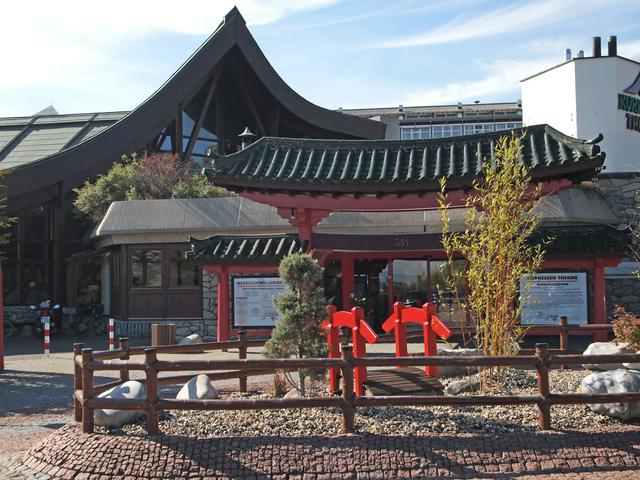
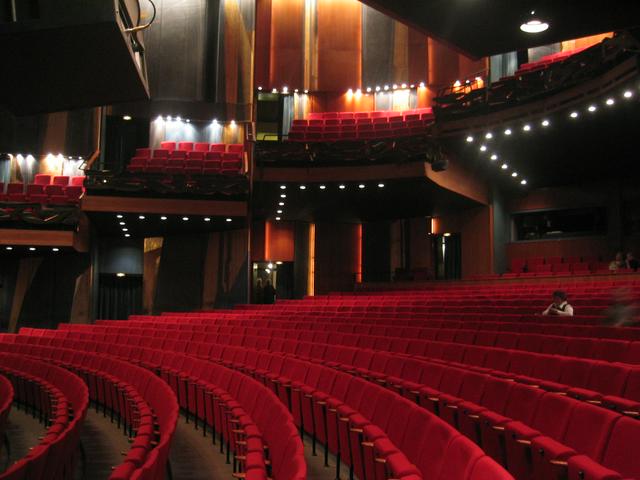
- Kurhessen Therme, Wilhelmshöher Allee 361, +49 561 318080. Su-Tu 09:00-23:00; W-Sa 09:00-24:00. Kurhessen-Therme (Line 1)
- Auebad Kassel, Am Auedamm 21, +49 561 7820. Daily 10:00-22:00. Auebad (Line 16)
Kurhessen Therme, Wilhelmshöher Allee 361, +49 561 318080. Su-Tu 09:00-23:00; W-Sa 09:00-24:00. Kurhessen-Therme (Line 1)
Auebad Kassel, Am Auedamm 21, +49 561 7820. Daily 10:00-22:00. Auebad (Line 16)
- Staatstheater Kassel, Friedrichsplatz 15, +49 561 10940. Staatstheater (Line 16)
Staatstheater Kassel, Friedrichsplatz 15, +49 561 10940. Staatstheater (Line 16)
- Cineplex, Wilhelmsstraße 2a, +49 561 700470. Rathaus and Rathaus/Fünffensterstraße
- Cinestar, Karlsplatz 8, +49 561 701711. Rathaus and Rathaus/Fünffensterstraße
Cineplex, Wilhelmsstraße 2a, +49 561 700470. Rathaus and Rathaus/Fünffensterstraße
Cinestar, Karlsplatz 8, +49 561 701711. Rathaus and Rathaus/Fünffensterstraße
- Kletterwald Kassel, Hohes Gras, +49 5251 8719471. Hohes Gras (Line 22)
- City Bowling, Bosestraße 1, +49 561 21077. M-Th 14:00-24:00; F 14:00-02:00; Sa 11:00-03:00; Su 10:00-24:00. Auestadion
Kletterwald Kassel, Hohes Gras, +49 5251 8719471. Hohes Gras (Line 22)
City Bowling, Bosestraße 1, +49 561 21077. M-Th 14:00-24:00; F 14:00-02:00; Sa 11:00-03:00; Su 10:00-24:00. Auestadion
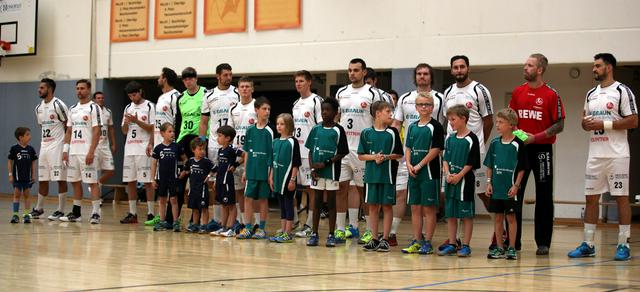
KSV Hessen Kassel is the most popular football club of Kassel and plays in the German Fourth Division (Regionalliga Südwest). The home stadium of the football club is the Auestadion. which is able to hold 18,000 people.
Kassel Huskies is a professional ice hockey and plays in the 2nd Eishockey-Bundesliga, but they played the majority of their seasons in the Deutsche Eishockey Liga, called DEL (1994–2006). The team plays in the Eissporthalle Kassel. (6100 people).
MT Melsungen is a handball club from Melsungen, but has it home in the Rothenbach-Halle. since 2007 which is able to hold 4300 people. The team plays in the German Handball-Bundesliga.
The Kassel-Marathon is one of the biggest and fastest marathons in Germany. In the programm are a children run, called Mini-Marathon, with a length of 4.2 km, a half marathon, a marathon and a marathon ekiden. Start and end is in the Auestadion in the south of Kassel. (www.kassel-marathon.de)
Getting a little bit out of the city can be a good thing. Around Kassel there are beautiful forests and ponds that have really good trails like the Habichtswald in the west or the Reinhardswald in the north. You can travel with buses direct into them (Bus 22 or 190).
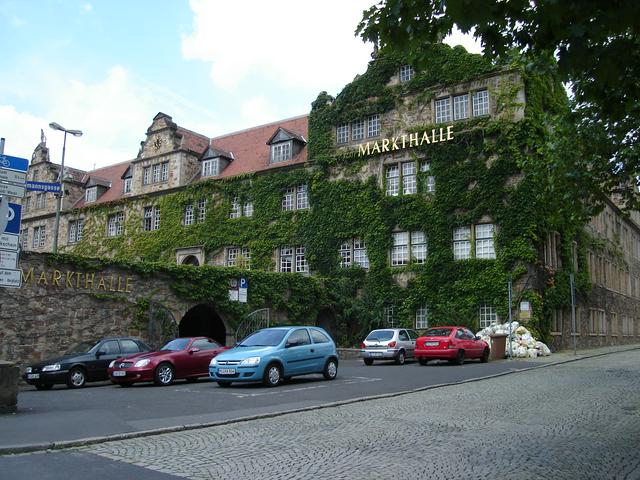 Shopping can be somewhat difficult in Kassel compared to the United States, but most of the good shopping is located close to the Königsplatz so if you get off the Straßenbahn (Tram) around there you can do most of your shopping with the usual big retail chains and many smaller shops.
Shopping can be somewhat difficult in Kassel compared to the United States, but most of the good shopping is located close to the Königsplatz so if you get off the Straßenbahn (Tram) around there you can do most of your shopping with the usual big retail chains and many smaller shops.
- Etuis-Mertl, Wilhelmsstraße 13, +49 561 16626. M-F 10:00-19:00; Sa 10:00-17:00.
- Hornschu, Oberste Gasse 3-7, +49 561 772329. M-F 10:00-19:00; Sa 10:00-16:00.
- Kletterkogel, Garde-du-Corps-Straße 1, +49 561 776192. M-F 10:00-19:00; Sa 10:00-18:00.
- Porzellanhaus Lange, Wilhelmsstraße 4a, +49 561 103333. M-F 10:00-19:00; Sa 10:00-16:00.
- Laufladen, Friedrichsplatz 12, +49 561 104475. M-Th 10:00-18:00; F 10:00-19:00; Sa 10:00-16:00.
- Scheibenbeisser, Fünffensterstraße 6, +49 561 5297026. M-F 10:00-19:00; Sa 10:00-18:00.
- Sound Brothers, Wolfsschlucht 17, +49 561 700090. M-F 11:00-19:00; Sa 11:00-16:00.
A lot of local shops you can find in the old market hall:
- Markthalle Kassel, Wildemannsgasse 1, +49 561 780395. Th-Fr 07:00-18:00; Sa 07:00-14:00.
Etuis-Mertl, Wilhelmsstraße 13, +49 561 16626. M-F 10:00-19:00; Sa 10:00-17:00.
Hornschu, Oberste Gasse 3-7, +49 561 772329. M-F 10:00-19:00; Sa 10:00-16:00.
Kletterkogel, Garde-du-Corps-Straße 1, +49 561 776192. M-F 10:00-19:00; Sa 10:00-18:00.
Porzellanhaus Lange, Wilhelmsstraße 4a, +49 561 103333. M-F 10:00-19:00; Sa 10:00-16:00.
Laufladen, Friedrichsplatz 12, +49 561 104475. M-Th 10:00-18:00; F 10:00-19:00; Sa 10:00-16:00.
Scheibenbeisser, Fünffensterstraße 6, +49 561 5297026. M-F 10:00-19:00; Sa 10:00-18:00.
Sound Brothers, Wolfsschlucht 17, +49 561 700090. M-F 11:00-19:00; Sa 11:00-16:00.
Markthalle Kassel, Wildemannsgasse 1, +49 561 780395. Th-Fr 07:00-18:00; Sa 07:00-14:00.
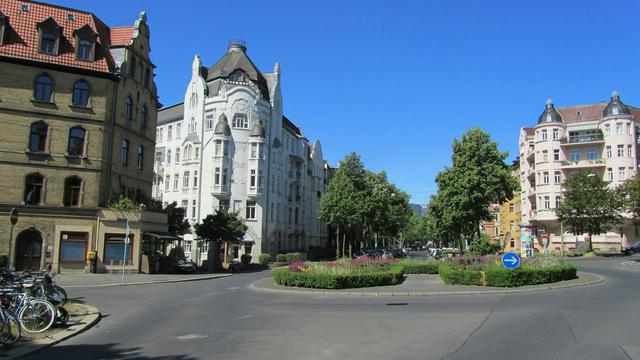
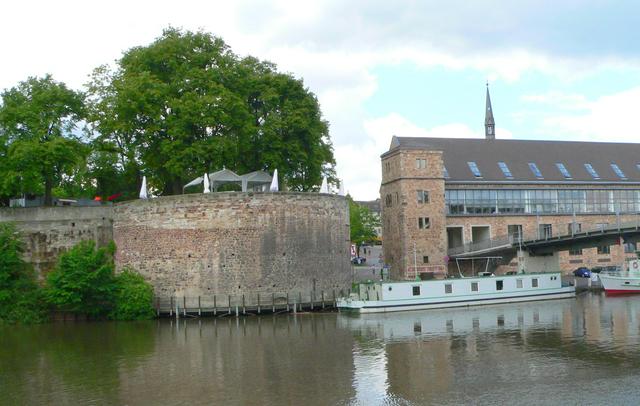
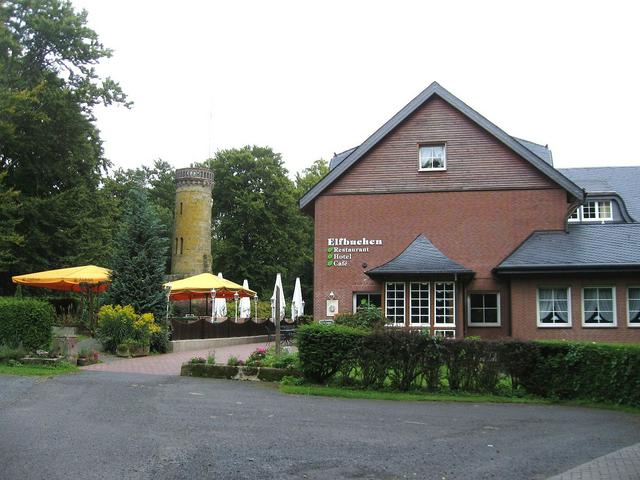 There are great bakeries on every corner and throughout the city. Another great place to eat is any of the little stands located in the City Point or Kürfürsten Galerie (city centre).
There are great bakeries on every corner and throughout the city. Another great place to eat is any of the little stands located in the City Point or Kürfürsten Galerie (city centre).
- Eckstein, Obere Königsstraße 4, +49 561 713300. Daily 11:00-24:00.
- Bolero, Schöne Aussicht 1a, +49 561 45010632. Daily from 12:00.
- Restaurant Orangerie, Am Auedamm 20b, +49 561 28610318. May-Oct: M-Sa from 12:00, Su 10:00-18:00; Nov-Apr: W-Sa from 12:00, Su 10:00-18:00.
- Humboldt 1a, Humboldtstraße 1a, +49 561 76649755. Tu-Su 14:00-23:00.
- Osteria, Jordanstraße 11, +49 561 773705. M-Sa from 18:00.
- Boccaccio, Querallee 36, +49 561 43020410.
- Eberts, Friedrich-Ebert-Straße 116, +49 561 7399230. M-Sa 09:00-24:00; Su 10:00-14:00.
- Eigenart 116, Wilhelmshöher Allee 116, +49 561 76608070. M-F from 11:00; Sa-Su from 10:00.
- Düsseldorfer Hof, Zwehrener Weg 6-8, +49 561 22176. Tu-F from 16:00; Sa from 17:00; Su 11:00-14:30, from 17:00.
- Restaurant Park Schönfeld, Bosestraße 13, +49 561 73976744. Tu-Sa from 18:00.
- Restaurant Bootshaus, Auedamm 27, +49 561 7394486. Daily from 12:00.
- Restaurant La Galleria, Wilhelmshöher Allee 262, +49 561 35306. M-Sa 12:00-15:00, 18:00-22:30.
- Restaurant Ilyssia, Lange Straße 83, +49 561 311793. M-F 17:30-24:00; Sa-Su 12:00-14:30, 17:30-24:00.
- Brauhaus Zum Rammelsberg, Rammelsbergstraße 4, +49 561 3162730. M-Sa 17:00-24:00; Su 12:00-24:00.
- Restaurant Gutshof, Wilhelmshöhe Allee 347a, +49 561 32525. M-Sa 17:00-24:00; Su 12:00-24:00.
Eckstein, Obere Königsstraße 4, +49 561 713300. Daily 11:00-24:00.
Bolero, Schöne Aussicht 1a, +49 561 45010632. Daily from 12:00.
Restaurant Orangerie, Am Auedamm 20b, +49 561 28610318. May-Oct: M-Sa from 12:00, Su 10:00-18:00; Nov-Apr: W-Sa from 12:00, Su 10:00-18:00.
Humboldt 1a, Humboldtstraße 1a, +49 561 76649755. Tu-Su 14:00-23:00.
Osteria, Jordanstraße 11, +49 561 773705. M-Sa from 18:00.
Boccaccio, Querallee 36, +49 561 43020410.
Eberts, Friedrich-Ebert-Straße 116, +49 561 7399230. M-Sa 09:00-24:00; Su 10:00-14:00.
Eigenart 116, Wilhelmshöher Allee 116, +49 561 76608070. M-F from 11:00; Sa-Su from 10:00.
Düsseldorfer Hof, Zwehrener Weg 6-8, +49 561 22176. Tu-F from 16:00; Sa from 17:00; Su 11:00-14:30, from 17:00.
Restaurant Park Schönfeld, Bosestraße 13, +49 561 73976744. Tu-Sa from 18:00.
Restaurant Bootshaus, Auedamm 27, +49 561 7394486. Daily from 12:00.
Restaurant La Galleria, Wilhelmshöher Allee 262, +49 561 35306. M-Sa 12:00-15:00, 18:00-22:30.
Restaurant Ilyssia, Lange Straße 83, +49 561 311793. M-F 17:30-24:00; Sa-Su 12:00-14:30, 17:30-24:00.
Brauhaus Zum Rammelsberg, Rammelsbergstraße 4, +49 561 3162730. M-Sa 17:00-24:00; Su 12:00-24:00.
Restaurant Gutshof, Wilhelmshöhe Allee 347a, +49 561 32525. M-Sa 17:00-24:00; Su 12:00-24:00.
- Café Nenninger, Friedrichsplatz 8, +49 561 7661690. M-F 08:00-19:00, Sa 09:00-19:30, Su 09:30-19:00.
- Café Lange, Friedrich-Ebert-Straße 72, +49 561 17138. M-F from 06:00, Sa-Su from 07:00.
- Café Streiter, Wilhelmshöher Allee 283, +49 561 9373157. M-F 06:00-19:00, Sa 06:00-18:00, Su 07:30-18:00.
Café Nenninger, Friedrichsplatz 8, +49 561 7661690. M-F 08:00-19:00, Sa 09:00-19:30, Su 09:30-19:00.
Café Lange, Friedrich-Ebert-Straße 72, +49 561 17138. M-F from 06:00, Sa-Su from 07:00.
Café Streiter, Wilhelmshöher Allee 283, +49 561 9373157. M-F 06:00-19:00, Sa 06:00-18:00, Su 07:30-18:00.
- Biergarten Rondell, An der Karlsaue, +49 152 29581684. Apr-Oct: M-Sa from 16:00, Su from 12:30.
- Backstube, Kochstraße 16, +49 561 27629.
Biergarten Rondell, An der Karlsaue, +49 152 29581684. Apr-Oct: M-Sa from 16:00, Su from 12:30.
Backstube, Kochstraße 16, +49 561 27629.
- York, Obere Königsstraße 4, +49 561 7397919.
- Club A.R.M./Lolita Bar, Werner-Hilpert Straße 22, +49 561 47396530.
- Unten, Joseph-Beuys-Straße 7, +49 561 81657150.
- Kulturzentrum K19, Moritzstraße 19, +49 561 8043803.
- Musikpark A7, Miramstraße 74, +49 561 95380340.
- Joe's Garage, Friedrich-Ebert-Straße 60, +49 561 18686.
York, Obere Königsstraße 4, +49 561 7397919.
Club A.R.M./Lolita Bar, Werner-Hilpert Straße 22, +49 561 47396530.
Unten, Joseph-Beuys-Straße 7, +49 561 81657150.
Kulturzentrum K19, Moritzstraße 19, +49 561 8043803.
Musikpark A7, Miramstraße 74, +49 561 95380340.
Joe's Garage, Friedrich-Ebert-Straße 60, +49 561 18686.
Kassel is usually very safe. Tourists normally do not get into the little problem areas from Kassel you can find in the northern and southern districts (Nord-Holland, Schillerviertel, Brückenhof, Mattenberg).
- Police: 110
- Emergency (fire, acute illness): 112
- Municipality: 115
- Klinikum Kassel, Mönchebergstraße 48e, +49 561 9800. Klinikum Kassel (Line 7)
- DRK-Kliniken Nordhessen, Hansteinstraße 29, +49 561 30860. Rotes Kreuz (Linen 1,3,4,7])
Klinikum Kassel, Mönchebergstraße 48e, +49 561 9800. Klinikum Kassel (Line 7)
DRK-Kliniken Nordhessen, Hansteinstraße 29, +49 561 30860. Rotes Kreuz (Linen 1,3,4,7])
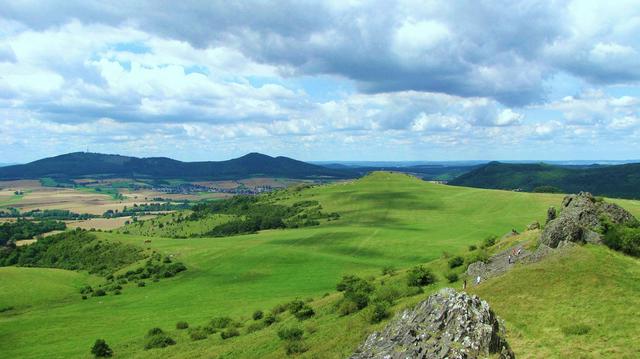
- Deutsche Märchenstraße (German Fairytale Road)
The Habichtswald and the Naturpark Habichtswald are located in the west of Kassel. You can find in the nature park châteaus as Schloss Wilhelmsthal., old castle ruins as the Weidelsburg. or worth seeing mountains as the Hoher Dörnberg. with Helfensteine, where also the Naturparkzentrum is located (bus line 117 from Zierenberg train station, lines R4/RT4). Medieval towns in the Naturpark Habichtswald are Zierenberg, Wolfhagen and Naumburg (Hesse).
The [[Habichtswald]] and the Naturpark Habichtswald are located in the west of Kassel. You can find in the nature park châteaus as Schloss Wilhelmsthal., old castle ruins as the Weidelsburg. or worth seeing mountains as the Hoher Dörnberg. with Helfensteine, where also the Naturparkzentrum is located (bus line 117 from Zierenberg train station, lines R4/RT4). Medieval towns in the Naturpark Habichtswald are Zierenberg, Wolfhagen and Naumburg (Hesse).
The [[Habichtswald]] and the Naturpark Habichtswald are located in the west of Kassel. You can find in the nature park châteaus as Schloss Wilhelmsthal., old castle ruins as the Weidelsburg. or worth seeing mountains as the Hoher Dörnberg. with Helfensteine, where also the Naturparkzentrum is located (bus line 117 from Zierenberg train station, lines R4/RT4). Medieval towns in the Naturpark Habichtswald are Zierenberg, Wolfhagen and Naumburg (Hesse).
The [[Habichtswald]] and the Naturpark Habichtswald are located in the west of Kassel. You can find in the nature park châteaus as Schloss Wilhelmsthal., old castle ruins as the Weidelsburg. or worth seeing mountains as the Hoher Dörnberg. with Helfensteine, where also the Naturparkzentrum is located (bus line 117 from Zierenberg train station, lines R4/RT4). Medieval towns in the Naturpark Habichtswald are Zierenberg, Wolfhagen and Naumburg (Hesse).
The Reinhardswald is an area associated with fairy tales and the stories of the Brothers Grimm, for example "Sleeping Beauty", who should lived on the Sababurg., an old castle in the middle of the forest. There are nice medieval and baroque towns around the Reinhardswald, like Hann. Münden in Lower Saxony or Bad Karlshafen in the north of Hesse. Visit also the Tierpark Sababurg., the oldest animal park of Europe and the Urwald Sababurg., the first Naturschutzgebiet of Hesse. Bus line 190 runs through the Reinhardswald from Hofgeismar train station, train lines RE17/RT1, or Hann. Münden train station, train lines RE2/RE9/R8.
The [[Reinhardswald]] is an area associated with fairy tales and the stories of the Brothers Grimm, for example "Sleeping Beauty", who should lived on the Sababurg., an old castle in the middle of the forest. There are nice medieval and baroque towns around the Reinhardswald, like [[Hann. Münden]] in [[Lower Saxony]] or [[Bad Karlshafen]] in the north of [[Hesse]]. Visit also the Tierpark Sababurg., the oldest animal park of Europe and the Urwald Sababurg., the first Naturschutzgebiet of Hesse. Bus line 190 runs through the Reinhardswald from Hofgeismar train station, train lines RE17/RT1, or Hann. Münden train station, train lines RE2/RE9/R8.
The [[Reinhardswald]] is an area associated with fairy tales and the stories of the Brothers Grimm, for example "Sleeping Beauty", who should lived on the Sababurg., an old castle in the middle of the forest. There are nice medieval and baroque towns around the Reinhardswald, like [[Hann. Münden]] in [[Lower Saxony]] or [[Bad Karlshafen]] in the north of [[Hesse]]. Visit also the Tierpark Sababurg., the oldest animal park of Europe and the Urwald Sababurg., the first Naturschutzgebiet of Hesse. Bus line 190 runs through the Reinhardswald from Hofgeismar train station, train lines RE17/RT1, or Hann. Münden train station, train lines RE2/RE9/R8.
The [[Reinhardswald]] is an area associated with fairy tales and the stories of the Brothers Grimm, for example "Sleeping Beauty", who should lived on the Sababurg., an old castle in the middle of the forest. There are nice medieval and baroque towns around the Reinhardswald, like [[Hann. Münden]] in [[Lower Saxony]] or [[Bad Karlshafen]] in the north of [[Hesse]]. Visit also the Tierpark Sababurg., the oldest animal park of Europe and the Urwald Sababurg., the first Naturschutzgebiet of Hesse. Bus line 190 runs through the Reinhardswald from Hofgeismar train station, train lines RE17/RT1, or Hann. Münden train station, train lines RE2/RE9/R8.
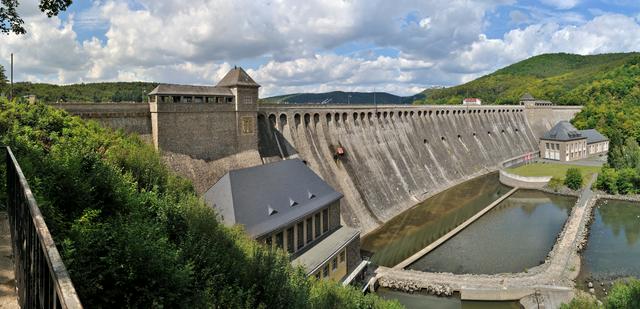 The Edersee is a reservoir and together with the Nationalpark Kellerwald-Edersee a multifaceted touristic area in the southwest of Kassel. Most famous are the Edersee Dam. and Schloss Waldeck., but there are also smaller sights and not to forget the objects, which you can just see when there is only very little water in the reservoir, like the Aseler Brücke (bridge). Around the Edersee and in the Kellerwald you can find a lot of hiking trails or cycle paths.
The Edersee is a reservoir and together with the Nationalpark Kellerwald-Edersee a multifaceted touristic area in the southwest of Kassel. Most famous are the Edersee Dam. and Schloss Waldeck., but there are also smaller sights and not to forget the objects, which you can just see when there is only very little water in the reservoir, like the Aseler Brücke (bridge). Around the Edersee and in the Kellerwald you can find a lot of hiking trails or cycle paths.
The Edersee is a reservoir and together with the Nationalpark Kellerwald-Edersee a multifaceted touristic area in the southwest of Kassel. Most famous are the Edersee Dam. and Schloss Waldeck., but there are also smaller sights and not to forget the objects, which you can just see when there is only very little water in the reservoir, like the Aseler Brücke (bridge). Around the Edersee and in the Kellerwald you can find a lot of hiking trails or cycle paths.
The Edersee is a reservoir and together with the Nationalpark Kellerwald-Edersee a multifaceted touristic area in the southwest of Kassel. Most famous are the Edersee Dam. and Schloss Waldeck., but there are also smaller sights and not to forget the objects, which you can just see when there is only very little water in the reservoir, like the Aseler Brücke (bridge). Around the Edersee and in the Kellerwald you can find a lot of hiking trails or cycle paths.
The Upland is the northeastern part of the Hochsauerland and Rothaar Mountains and a ski and hiking area. The most famous mountain is the Ettelsberg (837,7 m ü. NHN), because of the heath and the Hochheideturm., a 59 metre high observation tower, with a platform on 831 metres high. A cable car runs between Willingen and the mountain. Next to the Ettelsberg you can find the Mühlenkopfschanze., the largest ski jumping hill in the world with World Cup events every year.
The [[Upland (Hesse)|Upland]] is the northeastern part of the Hochsauerland and Rothaar Mountains and a ski and hiking area. The most famous mountain is the Ettelsberg (837,7 m ü. NHN), because of the heath and the Hochheideturm., a 59 metre high observation tower, with a platform on 831 metres high. A cable car runs between Willingen and the mountain. Next to the Ettelsberg you can find the Mühlenkopfschanze., the largest ski jumping hill in the world with World Cup events every year.
The [[Upland (Hesse)|Upland]] is the northeastern part of the Hochsauerland and Rothaar Mountains and a ski and hiking area. The most famous mountain is the Ettelsberg (837,7 m ü. NHN), because of the heath and the Hochheideturm., a 59 metre high observation tower, with a platform on 831 metres high. A cable car runs between Willingen and the mountain. Next to the Ettelsberg you can find the Mühlenkopfschanze., the largest ski jumping hill in the world with World Cup events every year.
- Göttingen (50 km) - famous university town in Lower Saxony (Georg-August-Universität)
- Eisenach (85 km) - with Wartburg, where Martin Luther translated the Bible into German; native town of Johann Sebastian Bach
- Marburg (90 km) - famous university town in Hesse (Philipps-Universität, one of Germany's oldest universities)
